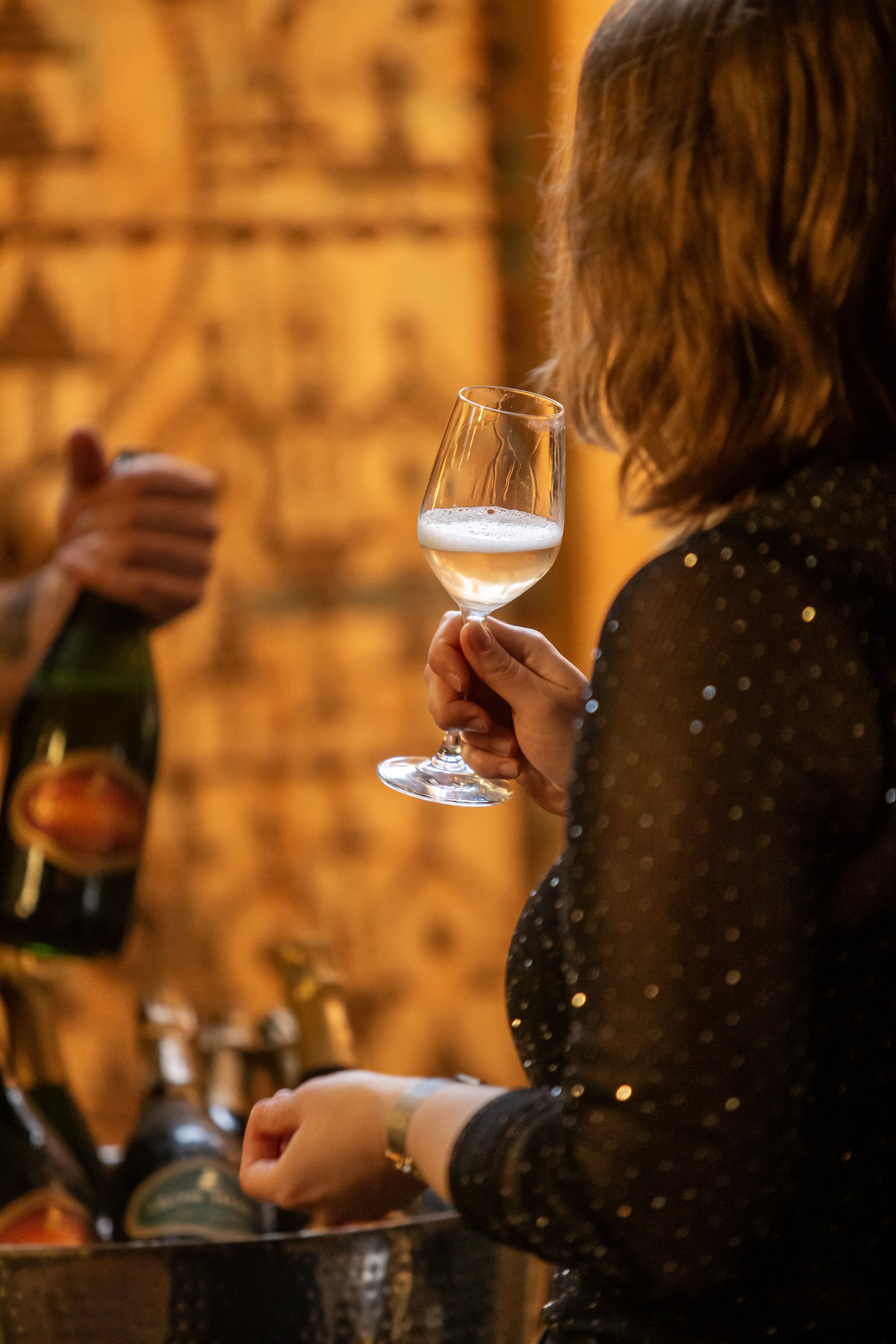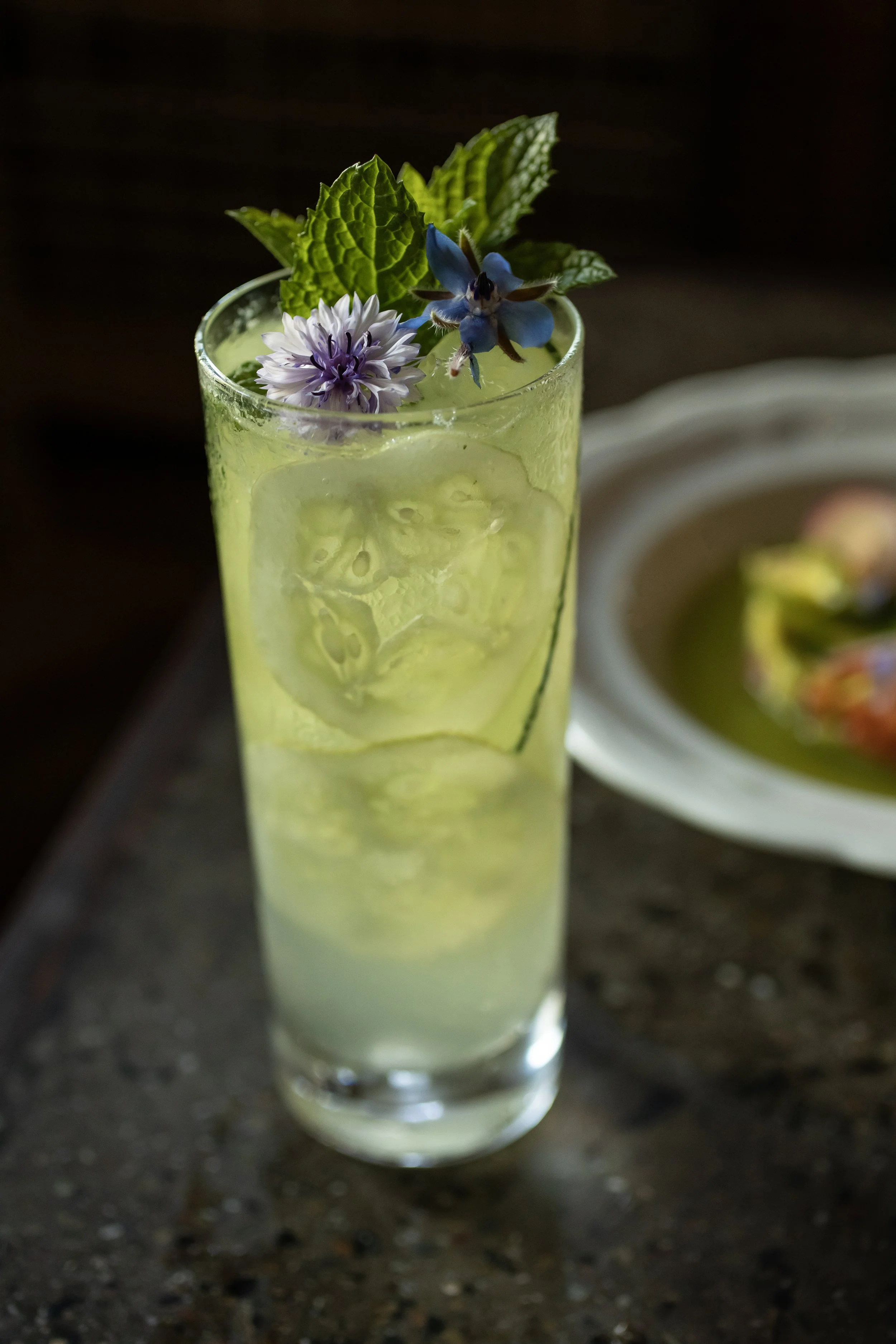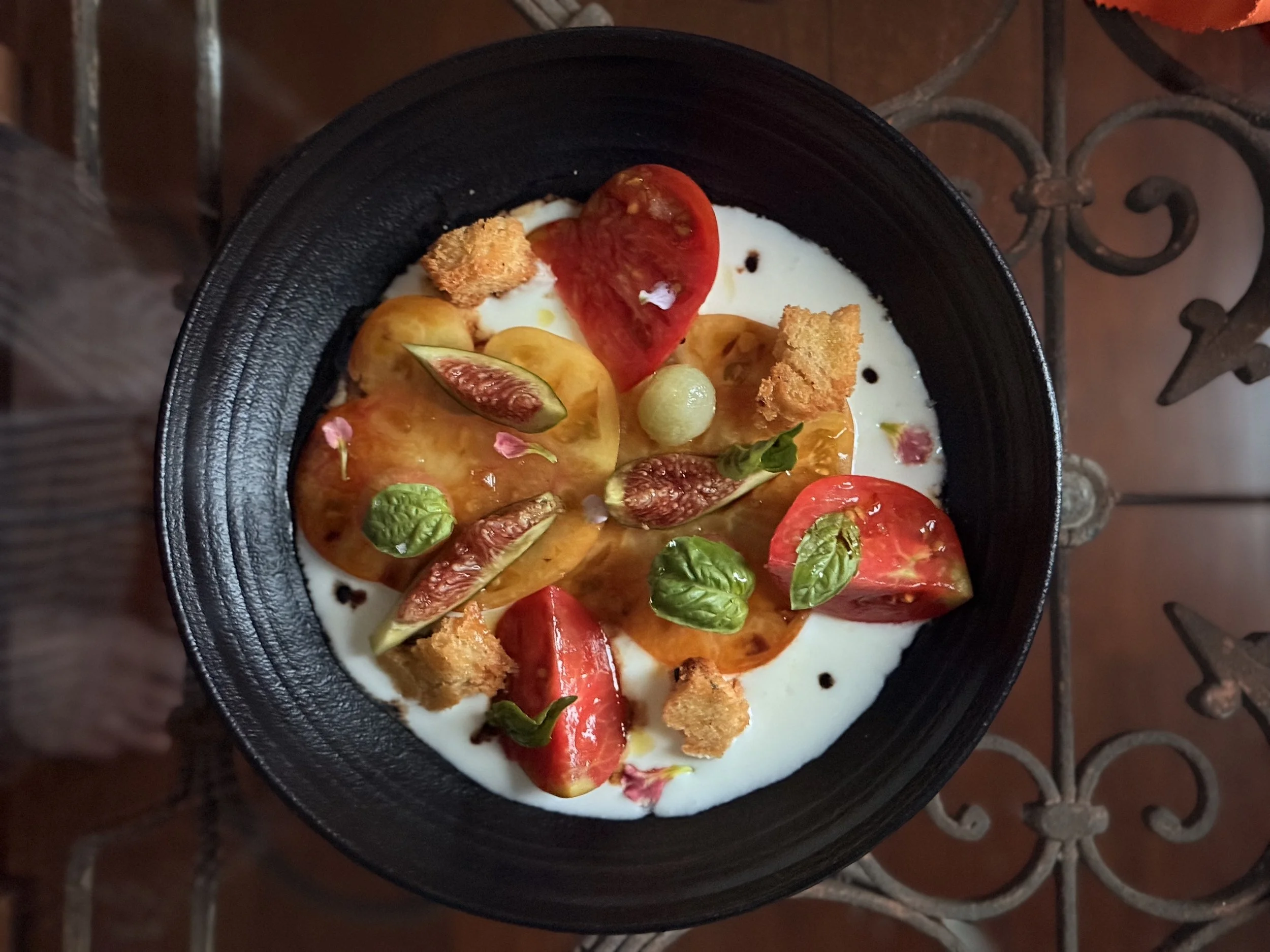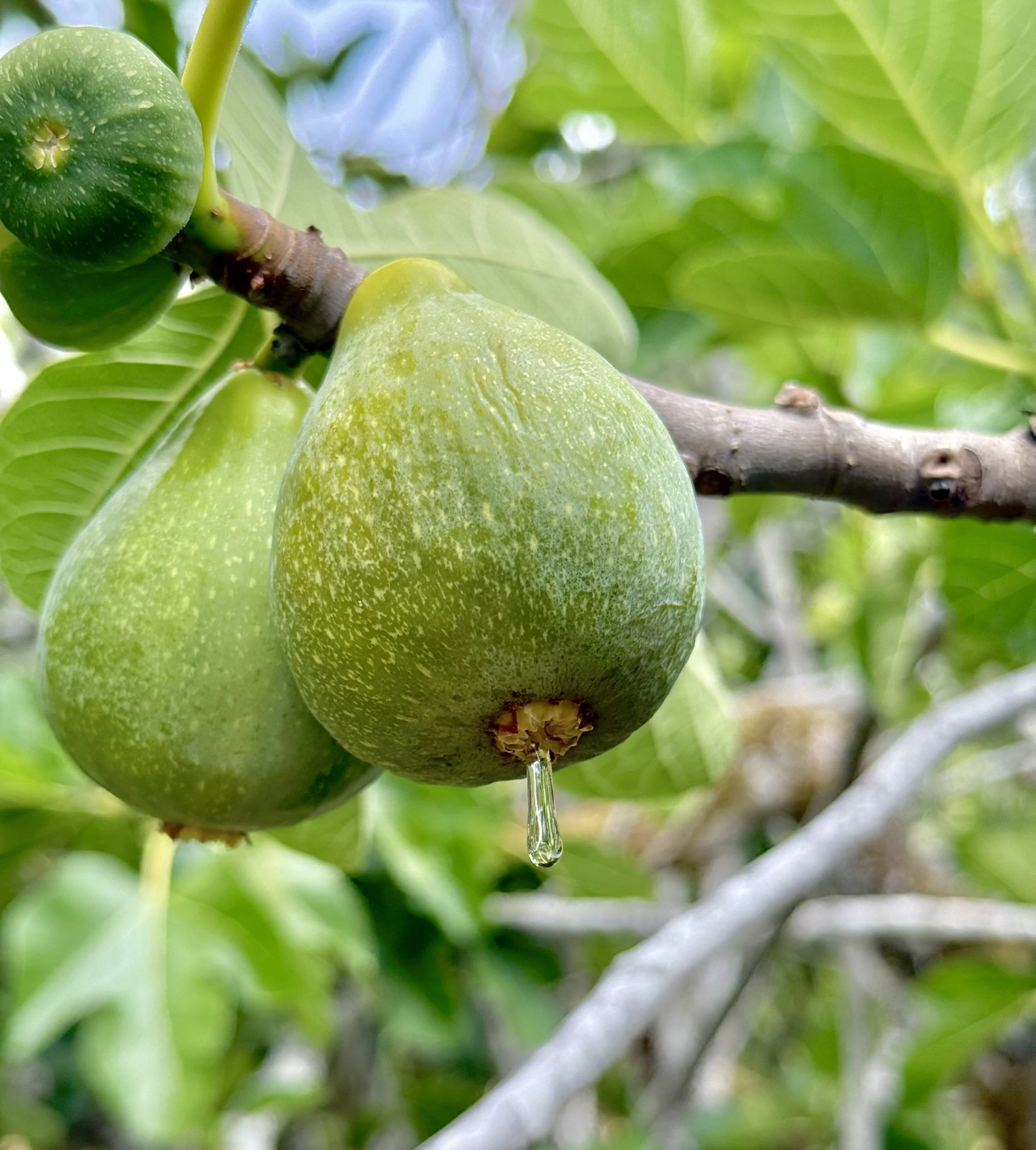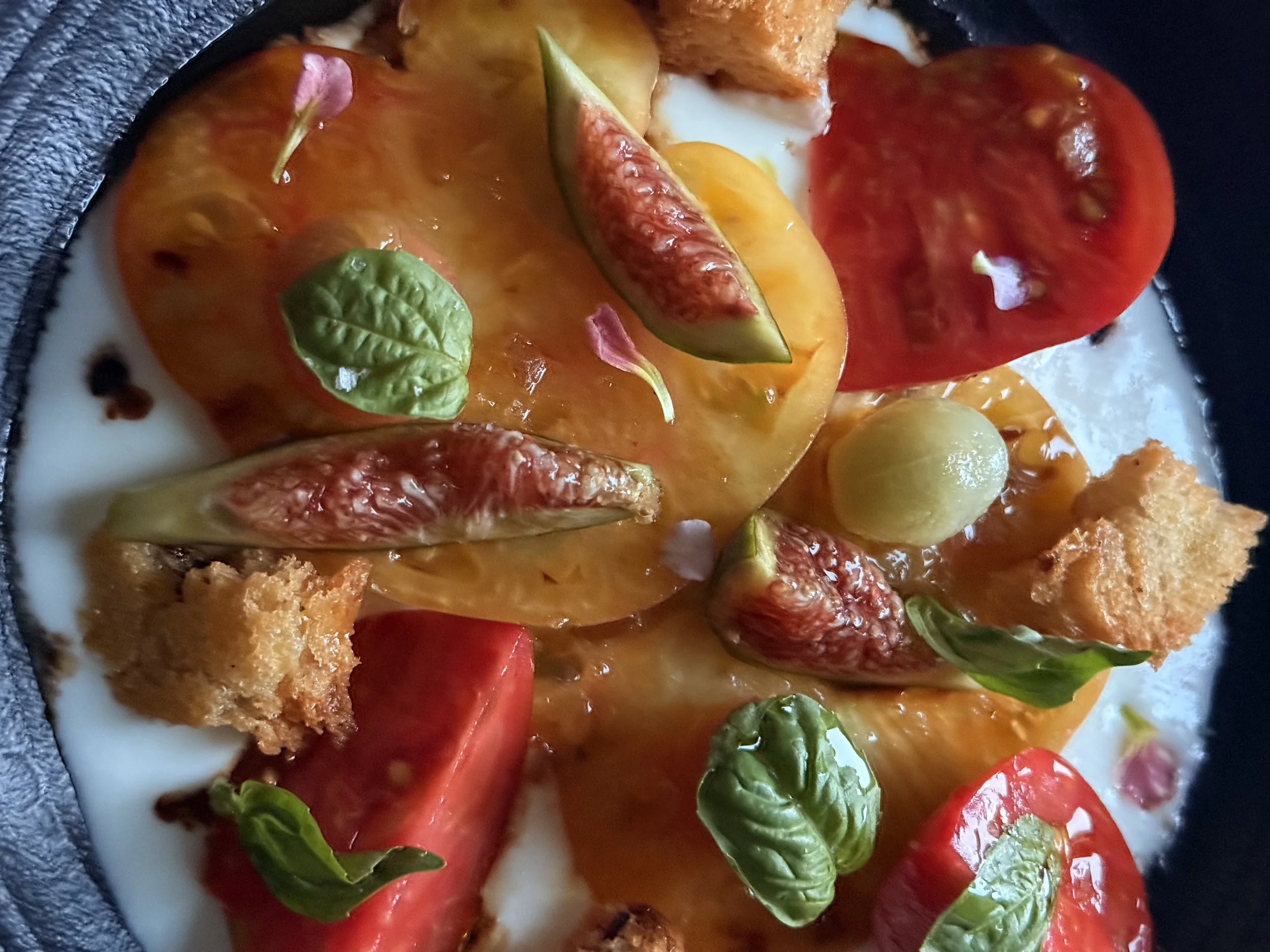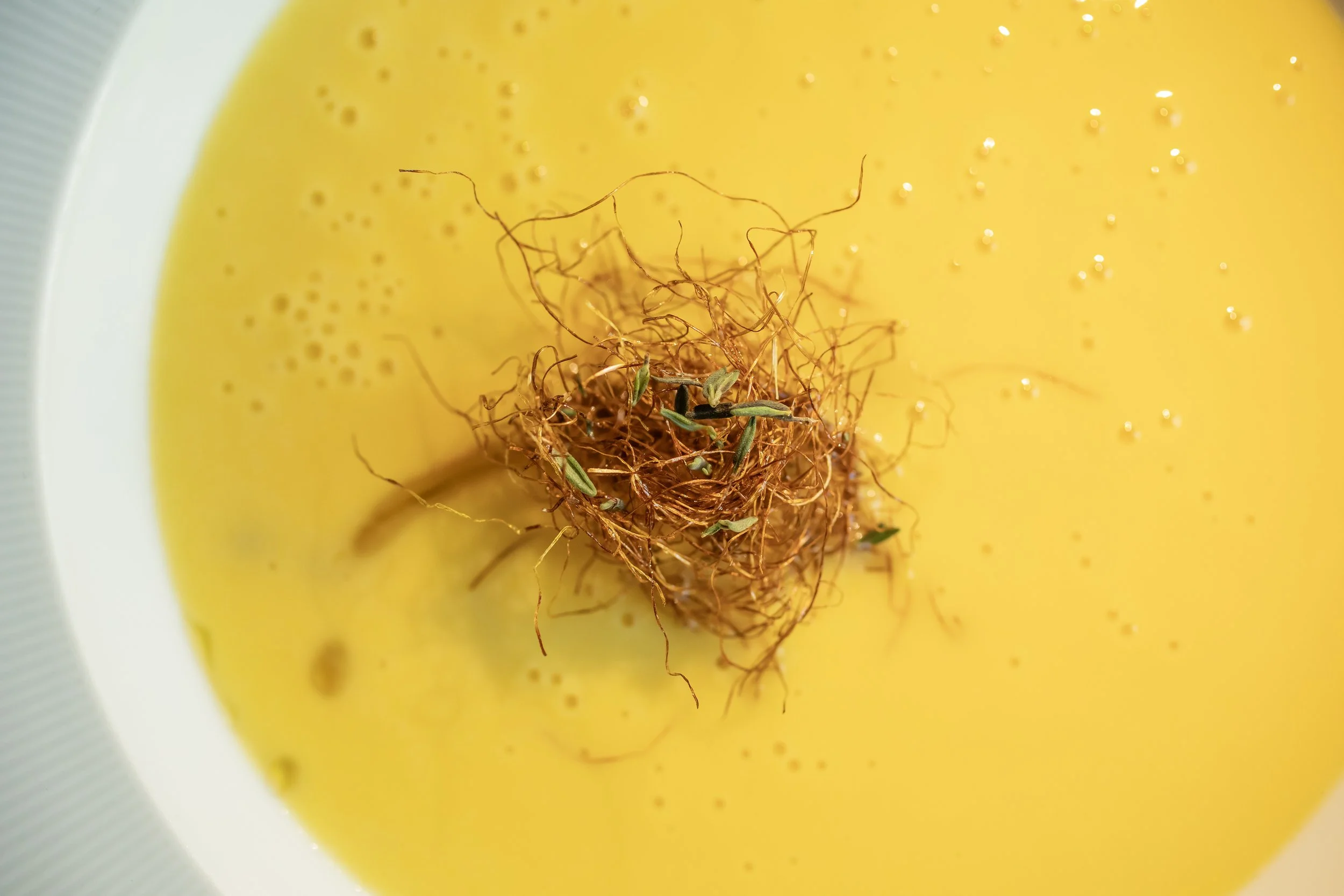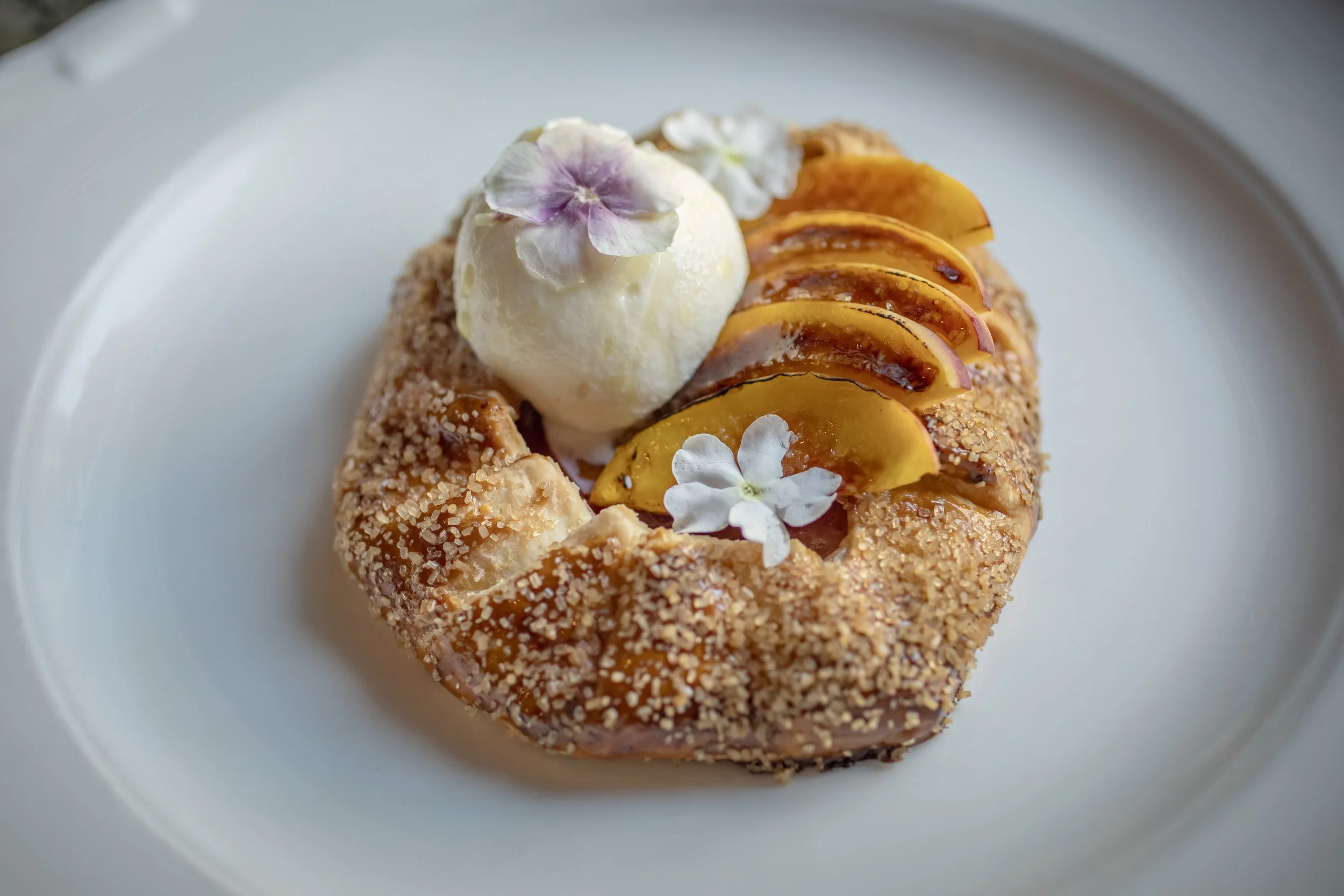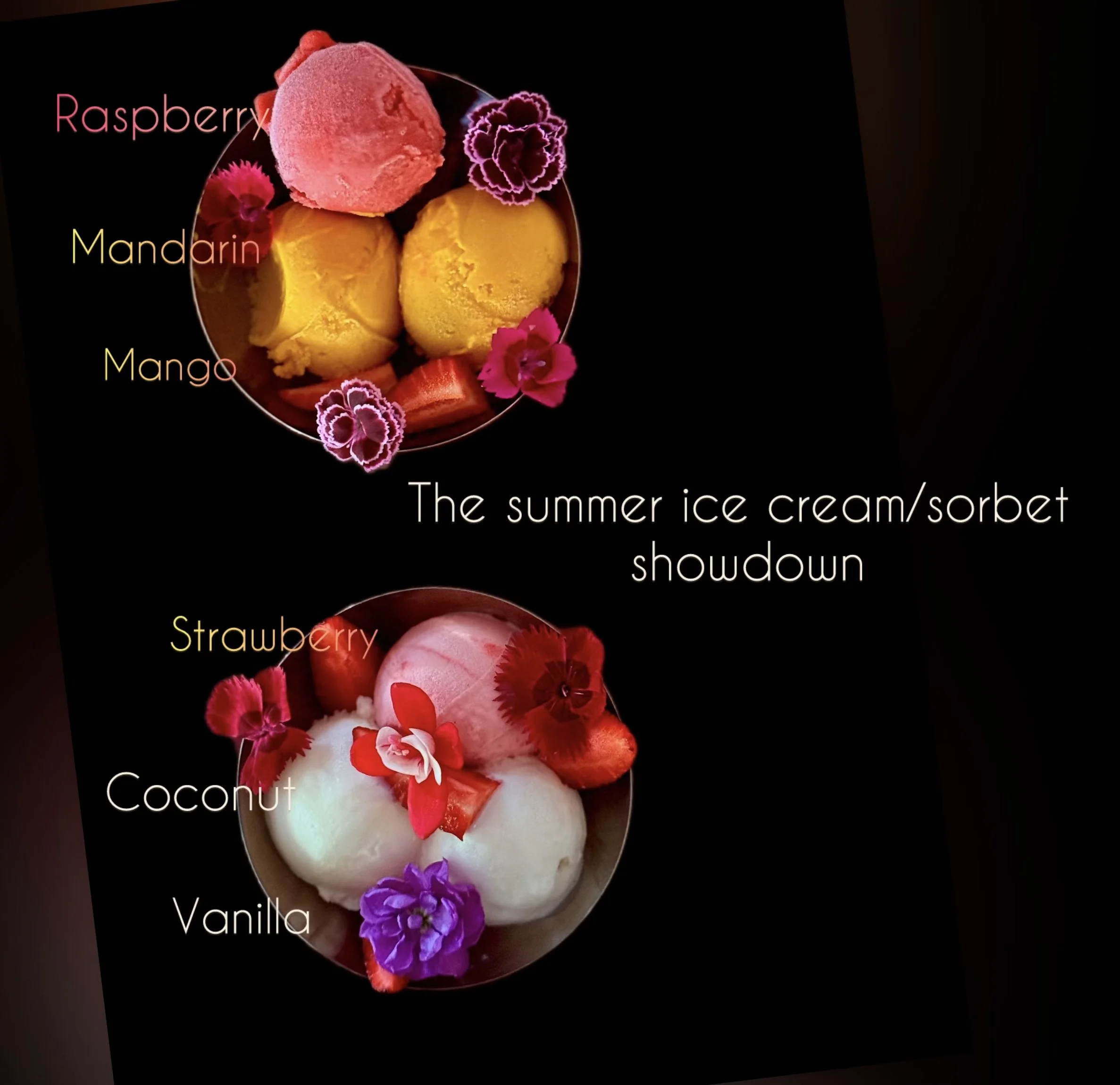While it’s hard to choose the best dishes we served in 2025, the temptation is irresistible…
Viewing entries in
Salad
Mid-August and while we are well aware the living ain’t always easy for much of the world, truth be told our cocktails, salads, cold soups and fruity desserts are exploding with summer’s juices and gorgeous life affirming color in our little corner of the world. Dining in the gardens is always wonderful to see - especially for families with children and couples with dogs.
Early in the evening more than half our guests still opt for Studio dining - cool tunes, air con, flooded with farm florals - but as the sun drops the best place in Barndivaland for a drink and a shared snack is on one of of the couches in the garden next to the edible flower beds we grow for the bar program, for scent, and guest delight.
We are a casual fine dining restaurant with the emphasis on fine dining. This means we truly prefer guests reserve for dinner so we come to every service on point. We welcome walk-ins for dinner - you just risk a wait without a reservation. The bar fills up nightly - and have also designated two Jordy Morgan sculptural hi-tops for drinkers. Even when the dining room is rocking we can manage shared plates - Our house made white bean hummus with garden crudites and a fresh green herby citrus oil, mounds of onion baji crunchy with salt and served with a coriander and mint chutney, and our notorious goat cheese croquettes- a barndiva favorite since the day we opened can always be ordered alongside a cocktail or a glass of wine.
The whole point of our move back to the Studio was to be able to accommodate this style of dining, inside and out; being able to offer dinner parties to larger groups; playing our B&W silent films on the barn wall, sharing our playlists, lighting the candles. Celebrating every season in our inimitable style and- for you as well as for us - just having a bit of fun enjoying a night out in Healdsburg.
By the time you read this the farm figs served the past few weeks on the heirloom tomato salad will be gone -they are fragile, and their season short. But tomatoes this year? Not to be believed. And Erik’s and David’s whipped mozzarella salad with fresh basil and crunchy croutons is the perfect carrier for all that summer tomato goodness. Barndiva farm fruits up next: comice and asian pears.
Brief too will be the fresh corn season and we celebrate it with a wonderful Erik Anderson chilled golden corn soup. The bowl arrives with a dollop of glorious Jimmy Nardello pepper jam made with a hint of sherry vinegar. The soup is poured table-side, and you just give it a stir -the better to re-discover the piquant ‘jam’ with every velvety spoonful. This is a dish that truly resonates with the season. It is topped with a tangle of crisped corn silk and a few petals of sweet garden thyme.
As for sweet endings: we’ve known Simon Mendoza since he was a boy. His father, Abel is one of Barndiva’s most valued chefs who has been with us for many years. Abel (and for a time his talented wife) have navigated every stage of our journey, while the kid, it turns out, was watching and if not taking notes, taking note of the parts that intrigued him. Turns out he has the talent and the chops for pastry. Simon is now turning out some of the best sorbets and ice creams in town - which I know is saying a lot. He’s baking as well: we were dreaming of a galette this summer and Voila, Simon has delivered. It’s a peach galette for now, soon to shift into pears and apples as they ripen here at the farm. His sorbets this week: raspberry, mandarin, mango. Ice Cream flavors will come and go with the season, except for vanilla which is sublime. Leave room for desert and celebrate young talent! Eat the view!
Dish of the Week
A Summery Microgreen Salad
Lucknam Park, the 500 acre estate where Geoff and I spent two blissfully sybaritic days at the tail end of our recent trip to England boasts an equestrian center, a world class spa and a Michelin star restaurant led by the extremely talented chef Hywel Jones. If you’re willing to spend a bundle England has a good number of historically luxurious country house hotels ~ Downton Abbeys with mod coms ~ to choose from. (For the ultimate in posh food and wine a la campagne, Raymond Blanc’s La Manoir aux Quatre Saisons is just up the road.) What brought us to Lucknam, however, was not the desire to spend a few days pretending to be 'to the manor born'. It was the chance to explore this part of Wiltshire on horseback, along with the compelling detail that in writing about their kitchen garden on their website, Lucknam had taken the time to wax poetic about their microgreens. Here in Healdsburg we are six months into a microgreens program that may soon involve building a dedicated greenhouse. My not-so-stealth mission was to find out if that made sense, and what Lucknam had that Barndiva didn’t.
The most obvious thing, of course, is the weather. Lucknam, an hour from Bath, has mornings blanketed with dense fog, ghostly shadows of towering plane trees followed by afternoon skies the bluest of blue, mischievous clouds playing endless games of hide and seek with the sun. Plants that drink water from the air love this kind of weather. While the main buildings date back to the Doomsday Book, improvements made over the centuries by a succession of heirless owners have thankfully been more sensible than grandiose, resulting in a series of well built cottages and renovated stables that feel like they have been kitted out by someone’s rich aunt. The nicest thing about the ground floor suites is the uninterrupted views they afford across faded formal gardens, parterres with buried fountains and lush green lawns which flow unimpeded into acres of open fields dancing with cover crop grasses.
The first day and night we fell into a stupor lulled by the slow ticking of clocks, the gleam of breakfast silver, spa, swim, spa, drinks in the library, and to cap it all off, a stunning gourmandise menu that Jones sent out ~ which was excellently wine paired and simply did not put a foot wrong. The second day I spent riding, then recovering from my ride, which again seemed to involve a good many libations, more spa and yet more food. Could one get used to this life of leisure? My guess is that one could.
It was only on the third morning that I remembered my mission and headed out into the mist to meet Lucknam’s charming lady gardeners, Lou and Sarah. Though they do it as a loss leader, as we do, Lucknam has an exciting microgreen planting schedule under the talented hands of these two gals. One hopes more of their guests will begin to take notice at the table, which will allow Jones to expand the kitchen garden program. They certainly have talent and land in abundance.
It must be noted that Ryan’s admiration for microgreens has its limitations ~ while he loves the ability to step outside into the gardens, especially to harvest herbs and edible flowers that do not travel well, anything with the word ‘micro’ in it needs to justify its culinary street cred. He especially abhors using microgreens as a garnish, going so far as to call the bit of fluff one (too) often finds on top of entrées “lazy plating.” Up to a point I’m on the same page, but where he believes most varieties have inherent heat which can throw the careful flavor layering of a dish off, I’ve come to disagree.
While heat is certainly present in the cress and mustard families, many microgreen varieties make it through the exceedingly short growing time ~ which can be as swift as five days ~ with subtlety and a range of fragrances that gently hint at the flavors of the full grown plant from which they take their name. Amaranth, chards, kales and micro basils are wonderfully creamy, earthy and herbaceous by turn, without being in the least overwhelming on the palate.
Below are some Lucknam Park microgreen varieties.
The fact that I am a new convert may account for my enthusiasm ~ until a few years ago I avoided microgreens completely as I simply (and stupidly) did not realize there was a difference between them and sprouts. I do not like sprouts. Something about the idea of growing and transporting produce in water, coupled with their wan flavor, has always made me queasy. I have since learned that because sprouts are just seeds, their first leaves are always pale and inedible, their stems an afterthought. With microgreens it’s all about a lilliputian world of crunchy stems and plump flavor packed leaves redolent of curious flavors that a mindful chef like Ryan can build upon. Add to this the fact that they are beautiful, dancing on the eye as if drawn by Matisse, and you have a good enough reason to embark upon yet another build and grow project. Stay tuned.
The microgreens in Ryan’s delightful summer dinner salad are delivered daily from Mix Gardens, Daniel’s Flats, or Earlybird’s Place. This week it featured blood sorrel, purslane, watercress, bachelor buttons, yellow and red beets, shaved purple carrot and calendula. It was lightly dressed with a citrus vinaigrette and slivers of opal and green basil from the raised beds here at the barn.
Eat the View.
All text Jil Hales. All photos Jil Hales (unless otherwise noted.)
Dish of the Week
Seared Tuna Niçoise with Saffron Aioli
 Before I tasted this dish on Sunday, the best Salade Niçoise outside of France I ever had was at Wolfgang Puck’s old Ma Maison on Melrose Avenue. It was a revelation, every wonderful Mediterranean flavor on the end of the fork: the sea, briny olives, crispy haricot vert, boiled potatoes glistening in virgin olive oil.
Before I tasted this dish on Sunday, the best Salade Niçoise outside of France I ever had was at Wolfgang Puck’s old Ma Maison on Melrose Avenue. It was a revelation, every wonderful Mediterranean flavor on the end of the fork: the sea, briny olives, crispy haricot vert, boiled potatoes glistening in virgin olive oil.
If you are a Niçoise fan like me you've probably suffered through innumerable misguided versions through the years trying to get back to the one that made you fall in love with this dish in the first place: overcooked fish the consistency of cardboard, sodden haricot vert, heavily sauced greens, quartered (sometimes halved) hardboiled eggs so dry they made swallowing a chore. What seems a simple dish is anything but.
Wolfie came to prominence the same time as Alice Waters, one of the first chefs who really knew how to source, though he worked his end of that passion down in Southern California. Sourcing is crucial to the dish but you also need a deft hand: each and every one of the ingredients needs to be treated with summertime love.
 It starts with the fish, which should have the texture of fine silk with a color somewhere between an overripe plum and Dior Rouge Blossom (a great lipstick color, check it out). Whether you poach it or flash sear it (as we do), when you finally glide a fork through the center the fish should be the texture and glorious color it had when it first came out of the sea. Chef uses Yellowtail, sushi grade. That's half the secret, the other is a light hand with the oil. I have a friend who swears canned tuna packed in OO makes a great Niçoise because "it is all about the oil," but while it's a dish that calls for an oily fish, I disagree. A light olive oil based dressing (ours is made with sherry vinegar and fresh basil) pulls all the ingredients under the same umbrella but each stands out ~ new potatoes, confit garlic, blanched haricot, green olives, ripe tomatoes. Ryan likes to add a spoonful of finely diced mirepoix which adds a bit of earthiness to the mix.
It starts with the fish, which should have the texture of fine silk with a color somewhere between an overripe plum and Dior Rouge Blossom (a great lipstick color, check it out). Whether you poach it or flash sear it (as we do), when you finally glide a fork through the center the fish should be the texture and glorious color it had when it first came out of the sea. Chef uses Yellowtail, sushi grade. That's half the secret, the other is a light hand with the oil. I have a friend who swears canned tuna packed in OO makes a great Niçoise because "it is all about the oil," but while it's a dish that calls for an oily fish, I disagree. A light olive oil based dressing (ours is made with sherry vinegar and fresh basil) pulls all the ingredients under the same umbrella but each stands out ~ new potatoes, confit garlic, blanched haricot, green olives, ripe tomatoes. Ryan likes to add a spoonful of finely diced mirepoix which adds a bit of earthiness to the mix.
All the ingredients are cooked separately, warmed together in olive oil at the last minute which sets off the fragrant magic of their particular compatibility. There's a reason this dish became the go to for 'ladies who lunch' as it manages to be both incredibly rich, yet healthy (their version of not fattening) ~ rumor says it was created for Balanchine one summer as he was knocking about by the seaside in Nice. Makes sense.
As for that egg, Chef is not interested in dumbing down the palate by either hard boiling then slicing or grating it so it disintegrates into mush- his serendipitous play on a Niçoise uses a single quail egg, lightly fried in OO. It's just big enough for the yolk, once broken, to give you a few creamy mouthfuls as it settles down into the acidic tang of the dressing without upstaging a sublime saffron aioli on which he mounts all the ingredients.
 For the next few months we are serving this Niçoise as a warm first course on the dinner menu. The single Calabrian pepper that sits on top, whose heat triggers the delight of everything that follows, reminds me of a flag on one of the little fishing boats in a Dufy painting. You can't see the sea from the Barn, but like Dufy, Ryan's edible semaphore makes me smile. Summer has arrived.
Eat the View.
For the next few months we are serving this Niçoise as a warm first course on the dinner menu. The single Calabrian pepper that sits on top, whose heat triggers the delight of everything that follows, reminds me of a flag on one of the little fishing boats in a Dufy painting. You can't see the sea from the Barn, but like Dufy, Ryan's edible semaphore makes me smile. Summer has arrived.
Eat the View.
Coming Soon...
Speaking of Eat the View, we're just about to release our 4 minute video of the same name. Working with Drew Kelly as we traveled across Sonoma County to Preston Vineyards, Bellwether Farms, Mix Gardens, Earlybird's Place and Daniel's Flats has been one of the most memorable experiences of the past few years. Even knowing all I do about the quality of work our staff is capable of, watching the footage we shot in the kitchen was a revelation. There's something about seeing action on film that heightens the small gestures you take for granted, in this case isolating the grace and skill they expend with every dish. We may have a small kitchen at Barndiva but, boy, do we make big memorable food.
Crowds at the opening reception for Salon des Sens were blown away but we can't wait to hear what you think, dear reader. Coming your way later this week!
All text Jil Hales. All photos Jil Hales (unless otherwise noted.)
Dish of the Week: Sweetbread Microgreen Salad
 No one really knows why they are called Sweetbreads, though a good guess might be that “pass the thymus gland” is not the sexiest come on in culinary history. Then again, when food is in short supply you probably don't care what an affordable ingredient is called. Intrepid and talented chefs have always found a way to cook the less salubrious parts of the animals we eat ~ brain, heart, intestine, feet, tails... glands. Our greatest techniques (and from them, our classic dishes) have not sprung from boredom, so much as necessity. Still, to paraphrase the bard, a thymus gland by any other name… is bound to sound more appealing.
No one really knows why they are called Sweetbreads, though a good guess might be that “pass the thymus gland” is not the sexiest come on in culinary history. Then again, when food is in short supply you probably don't care what an affordable ingredient is called. Intrepid and talented chefs have always found a way to cook the less salubrious parts of the animals we eat ~ brain, heart, intestine, feet, tails... glands. Our greatest techniques (and from them, our classic dishes) have not sprung from boredom, so much as necessity. Still, to paraphrase the bard, a thymus gland by any other name… is bound to sound more appealing.
The thymus gland has two parts, one in the throat and a larger lobe near the heart which is considered more desirable because of its size (though in truth they basically taste the same). Pastured veal is the animal of choice for most chefs. The traditional method to prepare them for cooking is to soak them in milk for 24 hours to soften, then blanch, shock in cold water, press, drain, and chill. At this stage you can easily peel the outer membrane and portion before cooking. Ryan braises his sweetbreads first, slowly heating them through, after which he dredges them in flour and secret spices (secret to me, at any rate) before a quick sauté in foamy butter and fresh thyme. This results in sweetbreads which have a beautiful crunch, yet are still bursting with meat juice.

As it turns out, when properly prepared, they actually are kind of sweet. It’s not a sugary sweet to be sure, but a soft, mild, loamy sweet, enhanced by the consistency of custard crossed with tofu. Serving them with a bright salad of microgreens, cress, shaved carrot, pickled onion, and mache makes for an inspired pairing, not least because it brings forward the mellow nuance of the sweetbreads, taking the dish in an unexpectedly light direction.
Talking to Daniel about our new microgreen program ~ which both he and Mix Garden supply ~ I’ve learned a lot about these funny little guys. They have a range of flavors ~ alliumous, herbaceous, floral, spicy ~ that is quite remarkable. The biggest surprise was to find that microgreens are not really true leaves at all, but something called cotyledons. Formed in the seed, if left to grow after breaching the soil they would swiftly fall off the plant and die. The word cotyledon comes from the Greek word for 'seed leaf'.
The microgreens Chef used for this dish were cotyledons from seedlings which, planted with the proper spacing would eventually have grown into Russian Kale, Early Wonder Beets, Dwarf Grey Sugar Peas and Large Leaf Mustard Greens.
I love this dish. It’s another delicious reason I’m thankful we live in an age when the ethical sense of eating every part of an animal we take such great care to raise has placed cuts like sweetbreads front and center. Happily, on thoughtful menus, in hands like Ryan’s, they produce the most revelatory share of wows every night.
Tickets yet?
They are going fast! Don't miss out on a chance to spend a great 'guilt free' afternoon of drinking, eating, and talking clothes as Studio Barndiva joins forces with the talented folks at Brush Salon to support the American Diabetes Association's Tour de Cure. Joining us with a wonderful runway fashion show will be four of Healdsburg's finest clothing shops ~ Susan Graf Limited, M Clothing, Outlander Men's Gear and Clutch. Barndiva will be doing the cocktails and food, Vin Couture will be pouring the wine.
The evening also includes an exciting live auction with auctioneer Lucy Lewand, KZST's Debbie Abrams as MC and DJ Fabian.
Come out and have some spring fashion fun while we raise money to help find a cure for diabetes.
Dish of the Week
Filet Mignon & Ricotta- Egg Yolk Ravioli with "just a salad on the side"
Lazar “El” Lissitzky was one interesting dude, an architect, designer, photographer and typographer who lived between the Czar’s downfall and the rise of Communism in a little window of time when a humanist approach to the arts in Russia was allowed to flourish. Though he played a role in some of the most revolutionary art movements catching wind in Europe at the time ~ developing Suprematism with Chagall, teaching in Germany with the Bauhaus ~ his lasting contribution was a unique visual language which considered the power of geometric form when projected into the third dimension. Alive today he’d probably be rich and famous at Pixar or Apple.
He was not, to my knowledge, ever a chef, nor does anything you read about him (except perhaps the fact that he once walked across Italy) indicate any interest in food beyond eating it. Yet I think about El a lot these days as I watch our dishes leave Barndiva’s kitchen.
 How important is the way food looks to our enjoyment of eating it? Ryan is fond of saying we eat with our eyes first, but do we actually taste things differently depending on the way we perceive them? If a great landscape painting has the power to wake us up to the beauty of nature, does a beautiful plate of food help connect us ~ even subliminally ~ to the place where it was grown, the people who raised or grew it?
How important is the way food looks to our enjoyment of eating it? Ryan is fond of saying we eat with our eyes first, but do we actually taste things differently depending on the way we perceive them? If a great landscape painting has the power to wake us up to the beauty of nature, does a beautiful plate of food help connect us ~ even subliminally ~ to the place where it was grown, the people who raised or grew it?
Pretentious looking food isn’t what I’m on about; a plate of “beautiful food” that makes no connection to taste ~ and through taste to a field or meadow or body of water ~ is as lost an opportunity as a painting appreciated for its technical prowess that does not have the power to move us toward a love of nature and from there, a desire to protect it.
 Over the past year shooting Ryan’s food for Dish of the Week, while I’ve enjoyed writing about all the tricks and clicks that separate the amateur from the professional cook, I find I keep coming back this question. Lazar's language for art had a social context which for him ~ given the times ~ made it relevant. His theory posed that if the right connections were made between the components of "volume, mass, color, space and rhythm," the eye would make an emotional connection to the work which supplied a meaningful narrative, even when the work was 'abstract.' That was art, this is food, but in a curious way the sensory connection we bring to cooking and eating is also the dominate force that defines our relationship to it. We eat to live, but we also live to eat. And the vibrant life of vegetables, the texture of proteins, the delicate colors of edible flowers, the filigreed edges of herbs have all the same compositional resonance we respond to in a work of art. What's more, we don't experience food in a fine dining setting from the prescribed museum distance; we are an essential part of the process, bringing to the experience a crucial interactive piece.
Over the past year shooting Ryan’s food for Dish of the Week, while I’ve enjoyed writing about all the tricks and clicks that separate the amateur from the professional cook, I find I keep coming back this question. Lazar's language for art had a social context which for him ~ given the times ~ made it relevant. His theory posed that if the right connections were made between the components of "volume, mass, color, space and rhythm," the eye would make an emotional connection to the work which supplied a meaningful narrative, even when the work was 'abstract.' That was art, this is food, but in a curious way the sensory connection we bring to cooking and eating is also the dominate force that defines our relationship to it. We eat to live, but we also live to eat. And the vibrant life of vegetables, the texture of proteins, the delicate colors of edible flowers, the filigreed edges of herbs have all the same compositional resonance we respond to in a work of art. What's more, we don't experience food in a fine dining setting from the prescribed museum distance; we are an essential part of the process, bringing to the experience a crucial interactive piece.
Fine dining is a hybrid art using the physical picture plane of a small 3D canvas with the repetitive timing of a theatrical production. It takes an enormously disciplined aesthetic. As a performance art it starts with sourcing, moves through the precision of cutting, prep and a range of cooking techniques (with and without heat) to the minutes before presentation. Only then are the final 'colors' added 'backstage' in a moment of intense choreography that can make or break ~ within seconds ~ everything that's come before.
 Think I'm crazy? Perhaps, but check out the visual appeal and the production values of what Ryan calls "a simple side salad" which we serve with the Filet Mignon and Ricotta-Egg Yolk Ravioli on the lunch menu: slivered dark heart carrots, red and gold beets, tiny toy box radishes, spicy micro sprouts and pineapple sage petals follow a sinuous line that transitions from raw to cooked ~ garlic confit, steamed baby carrots, artichoke hearts and pearl onions ~ halfway across the plate. What's interesting beyond the visual delight of the plating is the narrative arc of the dish, which manages to give equal billing to the salad and vegetables (and for crunch, two house-made lattice potato chips which look like they drifted onto the plate on a breeze) without upstaging the star of the show: a perfectly cooked Filet Mignon.
Think I'm crazy? Perhaps, but check out the visual appeal and the production values of what Ryan calls "a simple side salad" which we serve with the Filet Mignon and Ricotta-Egg Yolk Ravioli on the lunch menu: slivered dark heart carrots, red and gold beets, tiny toy box radishes, spicy micro sprouts and pineapple sage petals follow a sinuous line that transitions from raw to cooked ~ garlic confit, steamed baby carrots, artichoke hearts and pearl onions ~ halfway across the plate. What's interesting beyond the visual delight of the plating is the narrative arc of the dish, which manages to give equal billing to the salad and vegetables (and for crunch, two house-made lattice potato chips which look like they drifted onto the plate on a breeze) without upstaging the star of the show: a perfectly cooked Filet Mignon.
 There are few things in life as satisfying to a carnivore as a forkful of charred steak flooded with glorious golden egg yolk, but the umani seduction we get from eating animal proteins does not necessarily need to rely on the amount of it we consume. Ryan's plating, beyond its visual appeal, also reflects this evolving consideration, and choices that stretch from the plate all the way back to how and where we source our food.
There are few things in life as satisfying to a carnivore as a forkful of charred steak flooded with glorious golden egg yolk, but the umani seduction we get from eating animal proteins does not necessarily need to rely on the amount of it we consume. Ryan's plating, beyond its visual appeal, also reflects this evolving consideration, and choices that stretch from the plate all the way back to how and where we source our food.
As much as I respect (and try to adhere) to Michael Pollen’s #1 rule: “eat food, not too much, mostly plants", I don't believe any directive ~ no matter how sensible ~ can teach us as much as an actual experience we feel connected to. Dining is a journey, the more visual the better. Our appreciation and joy should be something we build upon, one which grows with every bite we take. Barndiva was created from a desire to feed people delicious food, sourced sustainably, leaving them wanting to eat with us again. Like Lazar Lissitzky, who believed in transformative art ~ the idea that beyond the experience of looking lay connections which could effect a society of change ~ I’d like to think we are also part of a transformative food movement.
Art first, food first, or for us, any thoughtful combination in between.
Tour de Cure
Studio Barndiva is thrilled to be working with our good friends David and Nicole at Brush Salon to help host their Couture for the Cure Fashion Show on Sunday, April 22 in support of the American Diabetes Association. Entertainment for the evening will be an exciting runway show courtesy of four of Healdsburg's most popular shops: Susan Graf Limited, M Clothing, Outlander Men's Gear and Clutch. Before the show Barndiva will provide cocktails and hors d'ouvres, Vin Couture will be pouring wine ~ so don't be late. A live and silent auction will augment the runway show which will star local and professionals models with hair and make-up by the talented folks at Brush. Space is limited for this very special evening. Great night, important charity. We hope to see you here.
To make reservations for dinner after the show, call us at 707 431 0100, and mention the show. For tickets to the event, see below.
All text Jil Hales. All photos Jil Hales(unless otherwise noted).
Dish of the Week
Serendipity Farm Persimmon and Pomegranate Salad with Crispy Lamb Neck Croquettes
 This is the perfect Early Winter dish that delivers all the satisfying meaty flavors we long for as the nights turn cold. The persimmons and pomegranates come from Bruce and Vicki Pate, who graciously opened their farm in Geyserville to us last week. If you think a single leafless persimmon tree with its gloriously colored fruit is Christmas beautiful this time of year, imagine an orchard full of them.
This is the perfect Early Winter dish that delivers all the satisfying meaty flavors we long for as the nights turn cold. The persimmons and pomegranates come from Bruce and Vicki Pate, who graciously opened their farm in Geyserville to us last week. If you think a single leafless persimmon tree with its gloriously colored fruit is Christmas beautiful this time of year, imagine an orchard full of them.
Admittedly, the lamb aspect of this dish would be a bit tricky for the home chef unless you have access to whole animals or are a member of a meat buying club. The beauty of nose to tail cooking goes beyond honoring an animal (and value for money); in great part it's rediscovering cuts like this. The first thing Chef did after breaking down the animal was to get a great stock going with roasted bones and cuts like the neck and shoulder. His braising liquid for lamb consists of white wine, fennel, tomato, rosemary and loads of fresh parsley. After a few hours in this braise, the succulent meat all but falls off the bone.
 Neck meat cooked this way has marvelous flavor, redolent of the braising liquid and the free range life of the animal. Our two lambs this week were raised at Lou and Susan Preston's biodynamic Family Farm on West Dry Creek where they played an important role fertilizing the soil as they grazed the fields and vineyards. To make the croquettes, the meat from the bones was rolled in saran wrap and refrigerated just long enough to hold its shape. Just prior to cooking, Ryan brushed the chilled 2” croquettes with Dijon mustard and rolled them in lightly seasoned Japanese breadcrumbs.
Neck meat cooked this way has marvelous flavor, redolent of the braising liquid and the free range life of the animal. Our two lambs this week were raised at Lou and Susan Preston's biodynamic Family Farm on West Dry Creek where they played an important role fertilizing the soil as they grazed the fields and vineyards. To make the croquettes, the meat from the bones was rolled in saran wrap and refrigerated just long enough to hold its shape. Just prior to cooking, Ryan brushed the chilled 2” croquettes with Dijon mustard and rolled them in lightly seasoned Japanese breadcrumbs.
 Because the meat is fully cooked before hitting the pan, the croquettes only need a few minutes in grape seed oil over high heat, just long enough for the breadcrumbs to turn golden and crunchy.
Because the meat is fully cooked before hitting the pan, the croquettes only need a few minutes in grape seed oil over high heat, just long enough for the breadcrumbs to turn golden and crunchy.
 Ripe but firm persimmons have an unusual flavor that isn’t sweet so much as fragrant, with a silken honeydew quality that pairs beautifully with the richness of the lamb. Use non-astringent varieties for taste and ease of cutting. I think Serendipity Farm’s persimmons were Jiros, but Chef was going with Fuyus, which are everywhere this time of year. Chef shaved the persimmon into semi-translucent overlapping slices which he used as a canvas for a composition of baby roasted artichokes, pickled red pearl onions, red and yellow endive and one of his current favorites ~ exquisite tiny radishes. A sprinkling of red pomegranate pips completed the dish. Pomegranates are lovely this time of year but always a bit fiddly. Ryan showed me a quick way to extract the pips from their membranes: slice them in half and, using the wider end of a big kitchen knife, whack away, holding the cut side over the plate. Depending on how your day went, you can have a nice therapeutic moment as pips rain down like a shower of rubies.
Ripe but firm persimmons have an unusual flavor that isn’t sweet so much as fragrant, with a silken honeydew quality that pairs beautifully with the richness of the lamb. Use non-astringent varieties for taste and ease of cutting. I think Serendipity Farm’s persimmons were Jiros, but Chef was going with Fuyus, which are everywhere this time of year. Chef shaved the persimmon into semi-translucent overlapping slices which he used as a canvas for a composition of baby roasted artichokes, pickled red pearl onions, red and yellow endive and one of his current favorites ~ exquisite tiny radishes. A sprinkling of red pomegranate pips completed the dish. Pomegranates are lovely this time of year but always a bit fiddly. Ryan showed me a quick way to extract the pips from their membranes: slice them in half and, using the wider end of a big kitchen knife, whack away, holding the cut side over the plate. Depending on how your day went, you can have a nice therapeutic moment as pips rain down like a shower of rubies.
In the Gallery
We always try to fill the Gallery with unique smaller gifts at Christmas time, and this year is no exception. Besides a (rapidly diminishing) table of ornaments, we have cotton tea towels from Portugal, hand-loomed scarves from India and Ethiopia, Alpaca throws from Peru, votive holders made from cinnamon bark and a small but highly eclectic selection of books and hard-to-source cocktail bitters.
One of our favorite items back in the Studio after a long, post-tsunami wait are the exquisite hand-blown blue and yellow whiskey/cordial/ you-name-it glasses from Sugahara.
Out of time to shop? Not sure what to get for that certain someone you don't know all that well (or perhaps know all too well)... The ever popular Barndiva Gift Certificate may be the the most thoughtful gift you give all season. If you can't make it into the Gallery, call (707.431.7404) and we will be happy to take your information and send the the gift certificate anywhere you want. They can also be purchased at the bar, where you can have a glass of wine or a cocktail while you contemplate how clever you are ~ really, how much easier can we make this?
The Countdown for 2011 has begun...
 We are always fully booked for our fabulous New Year's Eve soirée, with the rush for tables coming right about now. Last I looked, we were almost out of space ~ so book now if you are thinking of joining us for a "classic" six-course menu culled from what Chef feels are the best dishes he has cooked all year. Don't say you weren't warned! If you already have plans for NYE but would like to join us for a glass of bubbly or taste one or two of the dishes on the NYE menu, we will serving them à la carte from noon to seven. Seating for NYE (dressing up not required, but encouraged) starts at 8:30. Take a look!
We are always fully booked for our fabulous New Year's Eve soirée, with the rush for tables coming right about now. Last I looked, we were almost out of space ~ so book now if you are thinking of joining us for a "classic" six-course menu culled from what Chef feels are the best dishes he has cooked all year. Don't say you weren't warned! If you already have plans for NYE but would like to join us for a glass of bubbly or taste one or two of the dishes on the NYE menu, we will serving them à la carte from noon to seven. Seating for NYE (dressing up not required, but encouraged) starts at 8:30. Take a look!
And Finally...
Barndiva wishes all of you a joyous holiday season. We thank you for your continued support without which we could not and would not find the vision and resolve to do what we do. Make a joyful sound, friends, for truly we have no time to waste.
Merry Christmas and Happy Chanukah from all of us at BARNDIVA
All text Jil Hales. All photos Jil Hales and Dawid Jaworski (unless otherwise noted).
Dish of the Week
New Fall Menu
 The garden dictates changes to our menus virtually every week of the year. But while there’s no hard line in the sand that can be drawn to signal the end of one season and the beginning of the next, some weeks, like this one, the juggling we do to accommodate the superlative produce our farmers bring to the kitchen door is more dramatic than others. While heirloom beans, sprouts, quince, and pancetta all started to arrive in abundance this week, so did the last of the heirloom tomatoes. The crazy weather that had left Lazero’s fig trees still bursting with fruit also had chestnuts falling from our trees on the ridge in Philo … I know, there are worse problems to have in life. But it makes calling the menu below the "definitive Autumn" menu a bit of a stretch.
The garden dictates changes to our menus virtually every week of the year. But while there’s no hard line in the sand that can be drawn to signal the end of one season and the beginning of the next, some weeks, like this one, the juggling we do to accommodate the superlative produce our farmers bring to the kitchen door is more dramatic than others. While heirloom beans, sprouts, quince, and pancetta all started to arrive in abundance this week, so did the last of the heirloom tomatoes. The crazy weather that had left Lazero’s fig trees still bursting with fruit also had chestnuts falling from our trees on the ridge in Philo … I know, there are worse problems to have in life. But it makes calling the menu below the "definitive Autumn" menu a bit of a stretch.
I love this time of year for the crisp snap to the mornings, coming in from the chill to a kitchen fragrant with the smell of quince. Creamy Mushroom Ragù and classic Frisée salads with lashings of bacon. Lobster Risotto scented with preserved lemons. Ryan’s incandescent Cauliflower Velouté with caramelized florets, raisins, and brown butter almonds (he calls it Trail Mix). The menu is a blessing right now, a garden-sensitive work in progress, the first of the delicious holiday season to come.
CAULIFLOWER Velouté, Caramelized Florets, Raisin, Caper, Almond, Caviar 15 Caramelized Diver SCALLOP, Gnocchi, Brussels Sprouts, Quince, Pancetta 16 BUTTER LETTUCE, Champagne Vinaigrette, Orange, Radish, Shaved Carrot 10 Crispy PORK BELLY, Heirloom Bean Cassoulet, Tomato Marmalade, Chive 14 BEET & ENDIVE, Avocado, Apple, Walnut, Warm Chèvre 13 FRISÉE LARDON, Creamy Cabernet Vinaigrette, Garlic Croutons, Fried Hen Egg 15 Local FIG Salad, Bellwether Farms San Andreas, Almond, Shaved Radish 12 Cowgirl Creamery “MT, TAM”, Fall Fruit, Radish, Marmalade 18 “THE ARTISAN” Hand Made Cheeses, Charcuterie, Seasonal Accompaniments 39
LOBSTER Risotto, Corn, Crispy Garlic Chips, Preserved Lemon, Watercress 30 Crispy Young CHICKEN, Roasted Artichoke, Pancetta, Ricotta & Egg Yolk Ravioli 25 Wild Alaskan HALIBUT, Caramelized Brussels Sprouts, Butternut Squash Agnolotti, Bacon 28 Niman Ranch Tenderloin of BEEF, Creamy Morel Mushrooms, Yukon Gold Potato Tots, Carrot Purée 32 Crispy Leg & Sliced Breast of Sonoma DUCK, Spinach, Glazed Cipollini Onion, Caramelized Pear, Foie Toast 29 Bacon Wrapped PORK Tenderloin, Yukon Gold Potato Purée, Apple Marmalade, Caramelized Endive 27
Goat Cheese CROQUETTES, Wildflower Honey, Lavender 10 BD FRITES, Spicy Ketchup 10 Preston OLIVE OIL, Maldon Salt, Port, Chive 4
TASTING MENU Five course 75 Wine pairing 40 Tasting menus available for the entire table only
Chef Ryan Fancher
In the Gallery
 All that glitters is not gold...and thankfully isn't priced like it either. These cuffs and bracelets just in for Xmas are some of the coolest ~ and most affordable ~ we've had in years. Beautiful handcrafted pieces are arriving everyday ~ wire sculpture by Ismael, textiles from Ethiopia, antiques from Burgundy, glass from Syria, ceramics from Japan, and beautiful paintings and steel sculpture...from just down the road. Shop local this holiday knowing you are supporting talented artisans from all over the world.
All that glitters is not gold...and thankfully isn't priced like it either. These cuffs and bracelets just in for Xmas are some of the coolest ~ and most affordable ~ we've had in years. Beautiful handcrafted pieces are arriving everyday ~ wire sculpture by Ismael, textiles from Ethiopia, antiques from Burgundy, glass from Syria, ceramics from Japan, and beautiful paintings and steel sculpture...from just down the road. Shop local this holiday knowing you are supporting talented artisans from all over the world.
Above: Brass Squares Bracelet: brass plated metal squares nestle together to create this light and fluid bracelet with a warm, burnished patina. Great worn in multiples. Strung on elastic to fit most wrists. $35/ each
 left: Square Bead Cuff: Handcrafted brass-plated metal beads strung on wire and finished in softly antiqued tones. $35
left: Square Bead Cuff: Handcrafted brass-plated metal beads strung on wire and finished in softly antiqued tones. $35
middle: Liquid Bronze Cuff: Cast from high quality brass, has molten appearance. $45
right: Crocheted Pyrite Bracelet: Lustrous Pyrite married with gold vermiel make for a striking pairing. Comprised of seven strands of small pyrite beads intricately woven and bound together with gold-filled wire and clasp. $150
All text Jil Hales. All photos Jil Hales and Dawid Jaworski (unless otherwise noted)
Dish of the Week:
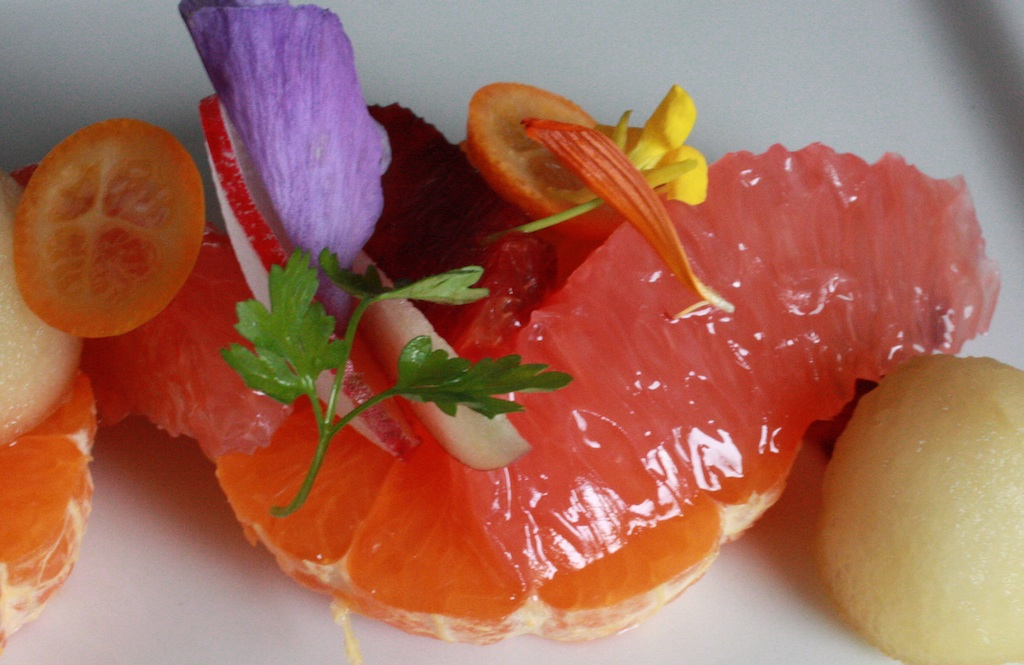 Bright jewel colors in the dead of winter are nothing short of magical and Chef Ryan's Winter Fruit Salad with Honeycomb is a case in point. Check it out: Navel Oranges, Blood Oranges, Page Mandarins, Ruby Red Grapefruit, Fuji Green Apple, chervil, chive, edible pansies, rapini, radish, & last but not least, slivered kumquats from Chef's own backyard tree. Interesting combinations result as the taste buds pick out fruity, floral and fresh green notes in the dish.
Bright jewel colors in the dead of winter are nothing short of magical and Chef Ryan's Winter Fruit Salad with Honeycomb is a case in point. Check it out: Navel Oranges, Blood Oranges, Page Mandarins, Ruby Red Grapefruit, Fuji Green Apple, chervil, chive, edible pansies, rapini, radish, & last but not least, slivered kumquats from Chef's own backyard tree. Interesting combinations result as the taste buds pick out fruity, floral and fresh green notes in the dish.
The dish also celebrates Chef's deft hand with Gastriques ~ sweet or savory reductions which are the result of sugar, often combined with fruit, caramelized until nutty brown, then cut with either vinegar or wine. Despite their reliance on sugar as a catalyst, gastriques are often savory for as sugar cooks, its sweetness subsides.
Most bistro dishes are a result of the classic line up: Marbled cuts of meat using salt and herbs to heighten flavor, wine to mellow, starch to carry the sauce. But the ultimate brightness in many of Ryan's classic French country dishes comes from his love and use of vinegar. Two gastriques here rely upon vinegar ~ the mandarin and the apple ~ to bring a brighter nose and sharper initial taste before they mellow on the palette.
When we can, we serve honeycomb with our artisan cheese plates to remind folks honey doesn't start out refined in a jar. The honeycomb served with this fruit salad comes from Hector's here in Sonoma County.
Bees have been much on our mind as of late, as the mysterious 4 year-old crisis of disappearing honeybees deepens. While a new heavy bee die-off this winter may be the result of extreme weather, no one really knows yet what's causing a worldwide hive collapse. Pesticides surely play a role, but sometimes I think ~ between CAFOs and suburbs ~ bees have just had enough. Say it isn't so.
all photos and text, Jil Hales, unless noted otherwise.
Dish of the Week:
Smoked Salmon Salad
 Smoked salmon has been a staple in Russian and Scandinavian diets for centuries, long before the world learned how good Omega 3s are for us. Like preserving, curing relies upon traditional techniques that extend our enjoyment of nature’s bounty, which is always a good thing.
Smoked salmon has been a staple in Russian and Scandinavian diets for centuries, long before the world learned how good Omega 3s are for us. Like preserving, curing relies upon traditional techniques that extend our enjoyment of nature’s bounty, which is always a good thing.
 Chef Ryan’s Cold Smoked Salmon is a dish of unusual color for the middle of winter: radish, mandarins, avocado, sunchoke chips, pickled onions, rapini, chervil, chives.
As a delicious nod to the dish’s Russian tradition, Chef included perfect cubes of cooked potato and a luxurious caviar crème fraîche dressing.
Chef Ryan’s Cold Smoked Salmon is a dish of unusual color for the middle of winter: radish, mandarins, avocado, sunchoke chips, pickled onions, rapini, chervil, chives.
As a delicious nod to the dish’s Russian tradition, Chef included perfect cubes of cooked potato and a luxurious caviar crème fraîche dressing.

 There are two stages to preserving salmon, which go hand in hand: brining and smoking. Brining draws water and moisture out of the fish, but care must be taken so the salt used in the brining process does not overwhelm the taste of the sea. By the same token, spices want to enhance, not interfere, with salmon’s hallmark flavor profile, which is sweet and rich.
There are two stages to preserving salmon, which go hand in hand: brining and smoking. Brining draws water and moisture out of the fish, but care must be taken so the salt used in the brining process does not overwhelm the taste of the sea. By the same token, spices want to enhance, not interfere, with salmon’s hallmark flavor profile, which is sweet and rich.
 Ryan prefers cold smoking to hot because as the temp never exceeds 90 degrees F, the fish cooks while retaining the translucent pliant texture it had raw. Cold smoked salmon is also easier to slice.
Ryan prefers cold smoking to hot because as the temp never exceeds 90 degrees F, the fish cooks while retaining the translucent pliant texture it had raw. Cold smoked salmon is also easier to slice.
 Chef made two dressings for the salad which ingeniously played off one another:
a sharp citrus vinaigrette (fresh squeezed lemon, orange, grapefruit and lime juice, virgin olive oil, apple vinegar, salt) followed by a languorous trail of caviar crème fraîche. The combination of the two brought out disparate but savory elements ~ from the sharpness of the pickled onion, through the green notes of chervil and chive, to the sweet citrus of mandarin. As for the meeting of caviar, crème fraîche and potato, it would have brought a smile to any Czar’s face. Or serfs like us.
Chef made two dressings for the salad which ingeniously played off one another:
a sharp citrus vinaigrette (fresh squeezed lemon, orange, grapefruit and lime juice, virgin olive oil, apple vinegar, salt) followed by a languorous trail of caviar crème fraîche. The combination of the two brought out disparate but savory elements ~ from the sharpness of the pickled onion, through the green notes of chervil and chive, to the sweet citrus of mandarin. As for the meeting of caviar, crème fraîche and potato, it would have brought a smile to any Czar’s face. Or serfs like us.
 I love salmon. But the truth is, we’re coming to the end of it. These days sustainably harvested salmon is a very rare treat. Alaskan troll-caught and California rod and reel, when you can find them, are the gold standard ‘wild’ alternatives to Loch Duart farmed. Next week we begin a discussion about sourcing fish mindfully. It’s a conversation all Chefs who are passionate about food needs to participate in, sooner rather than later.
I love salmon. But the truth is, we’re coming to the end of it. These days sustainably harvested salmon is a very rare treat. Alaskan troll-caught and California rod and reel, when you can find them, are the gold standard ‘wild’ alternatives to Loch Duart farmed. Next week we begin a discussion about sourcing fish mindfully. It’s a conversation all Chefs who are passionate about food needs to participate in, sooner rather than later.
The Fighter: Raw Course
Chiogga Beet Tartar, Caviar Moussaline, Mustard Vinaigrette, Sunchoke Chips
 The dish we paired with The Fighter was meant to be raw and bloody ~ though the ‘blood’ came from a vibrant beet tartar whose magnificent color was spiked with a bit of vinegar. It was topped with a moussaline of whipped crème fraîche, a dollop of caviar, and a wreath of baby sunchoke chips. Texturally, while the beets and sunchoke chips initially tasted very different, the earthy flavor profiles of both root vegetables played in concert when paired with the creamy moussaline and salty caviar.
The dish we paired with The Fighter was meant to be raw and bloody ~ though the ‘blood’ came from a vibrant beet tartar whose magnificent color was spiked with a bit of vinegar. It was topped with a moussaline of whipped crème fraîche, a dollop of caviar, and a wreath of baby sunchoke chips. Texturally, while the beets and sunchoke chips initially tasted very different, the earthy flavor profiles of both root vegetables played in concert when paired with the creamy moussaline and salty caviar.
Black Swan: Salad Course Butter Lettuce Salad, Ruby Red Grapefruit, Meyer Lemon, Virgin Olive Oil, Radish
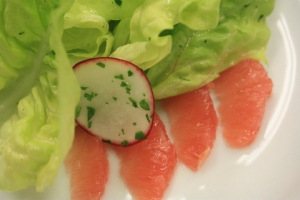 The idea behind serving a spare green salad to honor a movie about starving ballerinas started as a joke. Then Chef saw Black Swan and was actually incredible moved by Natalie Portman’s beauty and elegance. With it’s ruffle of butter lettuce, sharp crimson edge of radish, and delicate segments of ruby red grapefruit, the salad, finished with champagne vinaigrette and a shower of flowering rapini, was indeed a visual ballet of color and form. Delicious as well.
The idea behind serving a spare green salad to honor a movie about starving ballerinas started as a joke. Then Chef saw Black Swan and was actually incredible moved by Natalie Portman’s beauty and elegance. With it’s ruffle of butter lettuce, sharp crimson edge of radish, and delicate segments of ruby red grapefruit, the salad, finished with champagne vinaigrette and a shower of flowering rapini, was indeed a visual ballet of color and form. Delicious as well.
True Grit: Fire Course Veal Chop, Boulangère Potatoes, Golden Chanterelle Mushroom, Pickled Pearl Onion
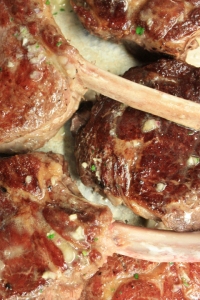 Back in the day, when people still cooked on the hearth, small town bakeries were often used by villagers to cook their evening meal in the still warm wood fired ovens once the bread run was finished. There wasn’t a lot of heat left and space was always at a premium ~ but I’m guessing some wonderful rustic recipes came out of this unique and very communal way of cooking. The story behind Boulangère potatoes was simple: meats were put on the top shelf with sliced potatoes beneath them, the better to catch the delicious meat drippings.
Back in the day, when people still cooked on the hearth, small town bakeries were often used by villagers to cook their evening meal in the still warm wood fired ovens once the bread run was finished. There wasn’t a lot of heat left and space was always at a premium ~ but I’m guessing some wonderful rustic recipes came out of this unique and very communal way of cooking. The story behind Boulangère potatoes was simple: meats were put on the top shelf with sliced potatoes beneath them, the better to catch the delicious meat drippings.
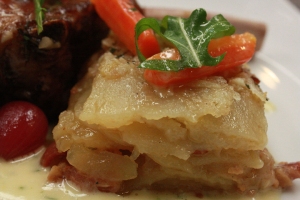 Ryan’s homage to the dish couldn’t involve a bread oven. But if you took your eyes away from the screen on Oscar night and closed them, it was easy to taste the inspiration. His savory layer cake of thinly shaved potatoes was saturated in dark stock that dripped down flavoring the potatoes during the baking process. Served alongside big juicy veal chops from milk and grass-fed free range calves, this was haute campfire with True Grit. The veal was sourced from Sonoma Direct, where Ritz Guggiana and his cookbook-writing daughter Marissa (Primal Cuts) find some of the most delicious ethically sustainable animals in the county.
Ryan’s homage to the dish couldn’t involve a bread oven. But if you took your eyes away from the screen on Oscar night and closed them, it was easy to taste the inspiration. His savory layer cake of thinly shaved potatoes was saturated in dark stock that dripped down flavoring the potatoes during the baking process. Served alongside big juicy veal chops from milk and grass-fed free range calves, this was haute campfire with True Grit. The veal was sourced from Sonoma Direct, where Ritz Guggiana and his cookbook-writing daughter Marissa (Primal Cuts) find some of the most delicious ethically sustainable animals in the county.
Toy Story 3: Sweet Course 3 flavors of Bon Bons
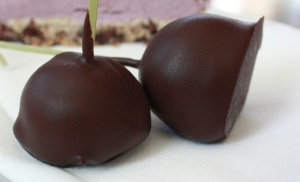 Opps. While the Journal’s photographer clearly remembers devouring the Toy Story 3 Bon Bon course just as Best Picture was announced, images of it clearly did not make it into the camera. The plate was a riot of color ~ with sprinkles, roasted coconut and almond flakes covering dark, milk and white chocolate Bon Bons filled with passion fruit, vanilla and crème fraîche ice cream. The good news is that the Bon Bons above are equally delicious and better yet, available often on our regular dessert menu.
Opps. While the Journal’s photographer clearly remembers devouring the Toy Story 3 Bon Bon course just as Best Picture was announced, images of it clearly did not make it into the camera. The plate was a riot of color ~ with sprinkles, roasted coconut and almond flakes covering dark, milk and white chocolate Bon Bons filled with passion fruit, vanilla and crème fraîche ice cream. The good news is that the Bon Bons above are equally delicious and better yet, available often on our regular dessert menu.
 Dish of the Week:
Dish of the Week:
Blonde Frisée Salad with Warm Garlic Crouton, Bacon, Pecorino, Hen Egg & Chives
 Bistro classics have enduring appeal, in part because of the virtuoso way they balance the rich comfort of full-flavored cuts of meat with the bright flavors of vinegar or wine. Taking a classic dish and updating it with panache is something Chef loves to do, and this salad is no exception.
Bistro classics have enduring appeal, in part because of the virtuoso way they balance the rich comfort of full-flavored cuts of meat with the bright flavors of vinegar or wine. Taking a classic dish and updating it with panache is something Chef loves to do, and this salad is no exception.
 The addition of crème fraîche to the vinaigrette is not traditional but it refines the connection between the meaty satisfaction of the lardons and the bracing clarity of vinegar. The salad is typically made with Frisée, aka frilly endive, which belongs to the chicory family. This often maligned salad green has a lot going for it when picked young and prepped with skill. A creamy vinaigrette clings to Frisée’s frilly edges like no other salad green. The blonde variety we use, soft and peppery in flavor, has a wonderful crunch. Other ingredients Chef Ryan incorporates to elevate the dish to an elegant dinner salad ~ without losing its essential bacon and eggs appeal ~ is a handful of mache, finely diced red onion, fresh chives, and a shaving of dry grated pecorino (the kind with lovely salt crystals).
The addition of crème fraîche to the vinaigrette is not traditional but it refines the connection between the meaty satisfaction of the lardons and the bracing clarity of vinegar. The salad is typically made with Frisée, aka frilly endive, which belongs to the chicory family. This often maligned salad green has a lot going for it when picked young and prepped with skill. A creamy vinaigrette clings to Frisée’s frilly edges like no other salad green. The blonde variety we use, soft and peppery in flavor, has a wonderful crunch. Other ingredients Chef Ryan incorporates to elevate the dish to an elegant dinner salad ~ without losing its essential bacon and eggs appeal ~ is a handful of mache, finely diced red onion, fresh chives, and a shaving of dry grated pecorino (the kind with lovely salt crystals).
 A softer loaf for your croutons will still give you the desired crunch without tearing at the roof of your mouth. All home chefs have their own methods of producing a crouton that has the requisite taste of garlic ~ only rule is to try and avoid the bitterness burnt garlic imparts. At Barndiva, as we make garlic confit almost daily for other dishes, we save the olive oil, fragrant with garlic, for our croutons.
A softer loaf for your croutons will still give you the desired crunch without tearing at the roof of your mouth. All home chefs have their own methods of producing a crouton that has the requisite taste of garlic ~ only rule is to try and avoid the bitterness burnt garlic imparts. At Barndiva, as we make garlic confit almost daily for other dishes, we save the olive oil, fragrant with garlic, for our croutons.
 There are two different cuts of Applewood smoked bacon in the salad ~ a thick dice, cooked slowly to melt the fat revealing the fullness of the pork belly, and thin strips of crispy grilled ‘breakfast’ bacon.
There are two different cuts of Applewood smoked bacon in the salad ~ a thick dice, cooked slowly to melt the fat revealing the fullness of the pork belly, and thin strips of crispy grilled ‘breakfast’ bacon.
These highly addictive pork nuggets are mixed into the salad along with the croutons, while the strip of bacon is strategically placed alongside the fried hen egg, perfect for dipping, triggering that classic bistro moment when the yolk breaks and a golden river flows through the dressed greens.
 All photos Jil Hales, unless otherwise noted.
All photos Jil Hales, unless otherwise noted.
Barndiva’s Valentine’s Dinner ~ 2011
Many a great chef has floundered on the sea of expectation that is otherwise known as ‘a romantic Valentine’s Dinner’. “It’s the equivalent of making love with your hands tied,” a chef once told me. “Even happy couples come in with weighted expectations.”
True, but confounding expectations are what’s great about love, right?
 We followed a hunch this year that the only thing couples who chose Barndiva for this very special meal didn’t want us to do was bore them. It was Chef’s idea to use the 5 senses to inspire each dish. When his insistence on a sorbet intermezzo between the entrée and dessert brought us to six courses we did some quick research on ‘the 6th sense’. Turns out premonitions- especially when they are of greater things yet to come- was perfect inspiration.
We followed a hunch this year that the only thing couples who chose Barndiva for this very special meal didn’t want us to do was bore them. It was Chef’s idea to use the 5 senses to inspire each dish. When his insistence on a sorbet intermezzo between the entrée and dessert brought us to six courses we did some quick research on ‘the 6th sense’. Turns out premonitions- especially when they are of greater things yet to come- was perfect inspiration.
 1st Course: Touch
1st Course: Touch
We started the meal with a Barndiva Classic, Warm Goat Cheese Croquettes, which beg to be eaten with your fingers. Golden salty crust, toothsome creamy filling with a heart of housemade tomato jam. Fingers used again to glide through rivulets of honey studded with lavender flowers.
 2nd Course: Sight
2nd Course: Sight
You eat with your eyes, first and foremost, but the mouth and the stomach have to follow for something to be both beautiful and delicious. The spirit of Matisse hovered above the salad course, a delightful dance of form and color: glistening gold and red beets, tutu pink and orange citrus, ripe avocado, blades of red radish, all atop a creamy mound of fresh crab meat. Nestled in a shower of Rapini flowers was a single tiny house-made Kennebec Potato Chip.
3rd Course: Smell
How to fully enjoy the aroma of our third course, a warm wide-lipped bowl of truffle flecked risotto? Some lifted it up and inhaled deeply, while others just closed their eyes, and slightly bowed their heads. There was no escaping the ethereal woodsy smell redolent of truffle oil. A big fat Maitake mushroom in a crispy tempura batter held pride of place, but the bravura touch was a halo of translucent crème fraîche foam.
4th Course: Taste
Though we offered a vegetarian option, most diners headed straight for the Snake River petite fillet seared and bathed in garlic, butter and rosemary for their main course. Sweet buttery batons of carrots, caramelized endive, and a mount of OMG Yukon Gold Potato Purée with lobster and crème fraîche sent the dish straight to Umami Heaven.
5th Course: Sound
The snap of a sweet and nutty Florentine was point of entry to our fifth course, a late intermezzo of bracing citron sorbet with slivers of grapefruit and mandarin citrus. Like a dip in a deep cold lake, it brought you to your senses, just in time for the final course.

6th Course: 6th Sense
Love is risk, we all should know that by now, so it’s a good thing that premonitions exist if only to remind us from time to time to trust our instincts. Which brings us to our 6th course, Temptation, a triple threat… but definitely not one to be afraid of. A Lady Gaga lunar hat of white chocolate balanced precariously on an orb of creamy passion fruit ice cream, which, in turn, sat melting on a couplet of moist dark chocolate ganache cakes. Lovers were encouraged to end the meal as they started it, intimately gliding their fingers through a passion fruit syrup the color of a Mexican sunset. We don’t know what they got up to after they left Barndiva but ‘our’ 6th sense tells us for most of them, the sweet notes continued.
(originally posted Dec 2010)


(originally posted December 22, 2010)

For the second to last newsletter of the year, we thought it would be fun (and relatively easy) to take a quick look back at all the ‘dish of the weeks' we compiled and choose a winner. Fun yes. Easy? Not a chance. We were blown away with the sheer volume of mouthwatering images and fascinating cooking tidbits chef and I managed to compile in one short year. Choosing a dish each week is not based on science (discovering a new technique) or math (what sold the most), it's an ephemeral decision made a few days, sometimes a few hours, before compiling ingredients and shooting them. We did not set out to build what has turned out to be a fascinating food journal (a calendar? The start of a cookbook?). Only two things mattered: the joy of working together and the connection each dish had to a built-in reverence for great raw product, which always guides us.
What began as a bit of entertainment, a way to make the newsletter a more enticing read for you, turns out to be the best Christmas gift we could have given ourselves ~ a grace note to a year that, while it tested us in every way possible, ended up being more nourishing ~ in all senses of the word ~ than any that has preceded it.
Dish of the Week is very much a collaborative project ~ just as every dish we send out to the dining room must be. In this, Chef Ryan, Lukka, Geoff and I are supported by an insanely talented kitchen staff. A special call out to Tommy, who has brought so much to the table (literally and figuratively) this, his first year with us, and to Pancho, Danny and Drew, who always have our backs. A special note of thanks as well to my incredibly talented assistant, K2, who patiently works with me every step of the way to capture the essential spirit of each dish.
In the end, we could not come up with a single winner ~ so we give you our favorite meat, fish and vegetable entrées. While each in a special way contributed to the food narrative we try to tell here at Barndiva, a remarkable taste profile combined with the beauty of Ryan’s plating ultimately won our vote.
2nd Runner Up...
Compressed Watermelon Herb Salad This dish was the height of elegant simplicity, but only one of many that hummed with glorious local color, matched by a wonderful taste profile that brought the farm right into your mouth. We are blessed to have many produce partners, thanks in part to Fork & Shovel speed dating events we host here at the barn every year. Two of our favorite veg and fruit producers, Early Bird's Place and Mix, also contract plant for us, a business partnership more thoughtful restaurants are discovering. One of our most popular blogs this year was the one about Myrna and Earl Fincher (October 6th) whom you can buy from at the Healdsburg Farmers Market.
Herbs for these dishes, like most coming out of our kitchen, were grown right here in our raised beds behind the gallery, or at Barndiva Farm in Philo where we also get our dry farmed apples, pears, figs, and chestnuts.
1st Runner Up...
Fritschen Vineyard's Lamb's Liver & Onions 2010 marked the beginning of our collaboration with the Fritschen Family, whose vineyards boast the grapes that Thomas DeBiase, our sommelier, makes into fine wine here in Healdsburg. For three weeks in July we chronicled a nose to tail cooking project that utillized almost every part of a beautiful animal raised for us at the Fritschen Family Farm. Whenever we can, we will continue to work with local farmers to procure excellent animal proteins for Barndiva. We do this despite a lack of local humane slaughterhouses that make these purchases more expensive than it need be for both farmer and chef. In the coming year, look forward to more lamb from Fritschen and the wonderful Preston Family Farm, along with goats and rabbits from new farms. Every season we list on our menus at Barndiva the primary purveyors who inspired us to create that specific menu. Some can be found at your local Farmer's Market if you live in Sonoma, Marin, or Mendocino County.
AND now...the winner is...
Escabèche! Keeping the fish and shellfish selections interesting for our customers continues to be a challenge for us as we try to honor a commitment to primarily source from waters within 100 miles of the restaurant. Though we keep an open mind to ongoing science about the safety of farmed fish, we do not serve it in Barndiva for a variety of reasons (taste being only one). When I spoke at a Seafood Symposium at the U.C. Davis Bodega Bay Marine Aquarium a few years back, (a wonderful event, the brainchild of my good friend Randi Seidner produced by Slow Food Russian River,) I made the point that some responsibility must fall on the diner when it comes to helping restaurants source sustainable fish and shellfish. If you say you want local, do not turn your nose up at varieties you are not familiar with when a restaurant you trust serves it! Happily, there is such faith in anything Chef Fancher sends out of his kitchen that we are able to stretch with less familar local selections without fear it will hit our bottom line. The dish here, Escabèche, is a case in point. It sold out every time it appeared on the menu, often as a result of someone just seeing it come to an adjoining table or hearing our servers talk about it. Make no mistake: when a line caught wild salmon walks in the door in the arms of one of our fishmongers, we grab it. We love local halibut and sole. In the coming year we may cast our net as far as Oregon and Washington's coastal waters, but no fish served at Barndiva will have taken a plane ride to get to your plate, or ever been frozen.
The full collection of our Dish of the Weeks, are available in the Barndiva Journal Archives- or keep reading...
(originally posted November 17, 2010)

Ever wondered what it looks like above Barndiva? Here's your chance. Great images and recipes by Chef Ryan accompany the article by Sarah Lynch in California Home + Design Magazine.
Raising the Barn: An International Aesthetic Meets the Best of Wine Country's Heartland
Photography by Drew Kelly and Brad Gillette

LEFT: Studio Barndiva’s eclectic offerings include local artwork and imported accessories, but the blue fireplace—adorned with a Magritte-worthy “It is not a fireplace”—makes it clear that visitors can always expect a surprise. TOP RIGHT: Jil and Geoffrey Hales built their barn (right) from scratch.
The perfect evening out brings together three elements: a delicious meal, a warm atmosphere and lively conversation. For Jil Hales, the proprietor of Healdsburg’s Barndiva restaurant, the bar is set significantly higher because the bar is where it all began.
“We came to Healdsburg eight years ago, after raising our kids in the U.K. and living in San Francisco for a few years,” says Hales, a Los Angeles native married to Geoffrey, a Brit, who brought his hardwood flooring company to the U.S. “What this town was missing was a world-class bar—a place to get a cocktail and a bite to eat late at night.”

LEFT: The kitchen island in the pied-à-terre was fitted with fluorescent lighting and colored gels as a prototype for the restaurant bar. RIGHT: A farm-worthy monitor, painted salmon pink, in the center of the ceiling will one day be accessed by a catwalk.
While the Hales were dividing their time between London and a fruit farm in Anderson Valley that Jil has owned for 30 years, they bought a property just off the town square in Healdsburg and built a two-story barn from the ground up. Downstairs, the bar and restaurant serve the best cocktails in town and an ever-evolving menu of farm-to-table dishes. Upstairs is the Hales’ pied-à-terre. Acting as general contractor and chief designer of the barn was an all-encompassing project, and Jil lived up to the nickname her friends had given her when she first moved to Anderson Valley: the Barn Diva.
Adapting the name to her new venture, Jil’s restaurant suitably hits a few high notes. From the outside, the building suggests a familiar rural vernacular—it’s a single structure with richly stained board-and-batten siding. Inside, the towering space is a sophisticated mix of travertine floors, wood tables, a colorfully lit bar and cream-colored walls adorned with modern art and antique farming tools. Out back, an enclosed garden is set with tables, big rustic sculptures and a trickling water feature; overhead mulberry trees are draped with twinkling fairy lights and a heritage black walnut offers dappled shade during the day.

FROM LEFT: The Cor-Ten steel and neon lights in Barndiva’s sign hint at the owners’ modern sensibilities; Studio Barndiva represents local artists such as painter Laura Parker and wire sculptor Ismael Sanchez; floor-to-ceiling drapes, formal flower arrangements and streamlined drum shades are just some of the sophisticated designs Jil chose for the restaurant; before coming to Barndiva
The pied-à-terre upstairs, which is accessed through the front door tucked alongside the restaurant’s entry patio and up a Dan Flavin-esque staircase with rainbow fluorescent risers, is even more of a surprise. It feels like a loft in Tribeca rather than a barn apartment in Sonoma County. The voluminous main room is centered on an oval dining table surrounded by red leather Eames Executive chairs. On one side a 16-foot-long kitchen island is topped with another fluorescent-lit bar (the prototype for the bar downstairs). The kitchen itself is an updated take on the European unfitted kitchen, with open storage, several sinks and a formidable black-enamel Lacanche range. A built-in bar adorned with Jil’s favored Tunisian ironwork, more classic midcentury furniture and artwork collected from around the world complete the scene in the main space. On one end is a guest bedroom and office mezzanine, and on the other is a master suite.
Two-and-a-half years after completing the barn, the restaurant was bustling on evenings and weekends, and Jil was ready to raise the bar even higher. The Hales’ life in Healdsburg had become increasingly focused on the community around them as they supported local vintners and farmers. But Jil’s passion for art and design needed an outlet, and the four walls of the restaurant were filled. So in 2007 she opened a gallery next door in a space that was formerly an opera house. Artists & Farmers, as it was originally called (now Studio Barndiva), was a place to celebrate and sell the art and designs she discovered locally or on her many travels. On display is an assemblage of Hales’ own lighting made from Tunisian architectural salvage along with locally crafted paintings, wire sculptures, blown glass, reclaimed wood furniture, imported gifts and accessories. “I don’t want to show things that can be easily found somewhere else,” says Hales, pointing out one exception: aselection of John Derian back-painted glass plates. “I know he’s in lots of other shops, but he’s a friend.”

LEFT TO RIGHT: The restaurant’s back patio features pendants that Jil fashioned from Tunisian window guards; fluorescent lights show up at the bar, where a circular backlit inset mimics the two round windows at the top of the building; the entrance to the private residence is marked by a dramatic glowing staircase; the weather in Healdsburg makes it ideal for outdoor wedding receptions.
Behind the gallery is yet another garden. This one is filled with raised vegetable beds, outdoor sculpture and a table large enough to seat 200 under an armature designed for a canopy of mini-globe lights. Like the garden on the other side of the fence, the setup begs for a modern country wedding and it’s been a popular spot for such events since it opened. In fact, Geoffrey and the couple’s eldest son, Lukka, run Barndiva’s event and hospitality business, and they’re now averaging 60 weddings a year. The Hales have also taken over management of the nearby Healdsburg Modern Cottages, four nightly cottages authentically furnished with pieces by Eileen Gray, George Nelson, and Ray and Charles Eames.

LEFT: The humble facade of Barndiva belies the stylish elegance of the experience inside. RIGHT: An outdoor area behind the gallery is attached to the restaurant’s garden through a gate and is a popular spot for wedding receptions.
In her mission to open a world-class bar in this sleepy town, Jil has elevated the creation of the perfect evening to an art form. “I went for the type of environment where I would want to share a meal or toast a special occasion with friends,” she says. “If something doesn’t come from the heart, it just doesn’t work. If you’re not authentic, you’re running on fumes.”
Sitting under twinkling lights, as a parade of seasonal dishes made by Thomas Keller–trained chef Ryan Fancher, original cocktails and wine selected by the in-house sommelier passes by, it would be hard to argue against that.
Recipes from Barndiva’s Chef Ryan Fancher
Both of these recipes make the most of fruit and vegetables in late summer or early autumn, when ingredients are at the height of their season. They are great dishes to source at a local farmers market.

Barndiva’s Heirloom Tomato & Compressed Watermelon Salad Serves 4
1 medium watermelon 1 tsp. lemon verbena 1 large golden beet 1 large Detroit dark-red beet 6 heirloom tomatoes 2 Tbsp. sweet basil 4 Tbsp. Spanish sherry vinaigrette Salt and freshly ground pepper 1 cup purslane (optional) 2 Tbsp. crystallized ginger, diced 2 red radishes
Spanish Sherry Vinaigrette 1 cup grape seed oil 1/3 cup Spanish sherry vinegar A pinch of salt, sugar and freshly ground pepper
• The Watermelon - The night before or a few hours before serving, cut into large cubes and sprinkle with the chopped lemon verbena. Wrap tightly in plastic wrap and refrigerate. • The Beets - Cover with 2 cups water, 1 Tbsp. butter, 1 clove garlic and a sprig of thyme. Cover and cook at 350° for 3 hours. Cool and slice. • The Heirloom Tomatoes - Slice them thickly and mix them in with the chopped sweet basil. In a bowl, whisk together all of the ingredients for the vinaigrette. Bathe the tomatoes in 4 tablespoons of the vinaigrette for 30 minutes or more. Season with salt and freshly ground pepper. • Assemble - Stack the tomatoes, largest one on the bottom. Arrange the watermelon. Dress the beets in the bathing vinaigrette, season with salt and pepper, and plate. Sprinkle ginger and thinly sliced radishes over the dish. Dress the purslane, and add it to the dish to finish.

Herb-Roasted Local Halibut Serves 4
8 baby artichokes 2 Tbsp. canola oil 4 cloves garlic 2 springs rosemary Salt and pepper 20 fava beans 1 zucchini 1 gold bar squash 5 lbs. Roma tomatoes 15 Toy Box cherry tomatoes 2 Tbsp. extra virgin olive oil 4 6-oz. halibut filets 1 Tbsp. butter 1 cup tempura batter 4 squash blossoms
Tempura batter 1/2 cup flour Corn starch 1 tsp. baking powder 1/2 cup sparkling water Salt
• The Baby Artichokes - Peel the outside layers to reveal the heart. In a hot pan, roast the artichokes with canola oil, garlic and rosemary until soft. Season with salt and pepper. • The Fava Beans - Peel the favas, and cook them in boiling salted water for one minute. Let cool. • The Summer Squash - Cut the zucchini and squash into diamond shapes, and cook them just like the fava beans. • Vierge sauce - Puree the tomatoes, and strain the clear liquid from the tomatoes through a clean kitchen towel. In a saucepan over medium heat, reduce the liquid by half, and season with salt and pepper. Drizzle extra virgin olive oil. • Halibut - In a hot sauté pan, sear the fish until golden brown, being careful to not overcook. Baste with butter, garlic and rosemary. • Assemble - Pool the sauce in a bowl or shallow plate. Arrange the vegetables in the sauce, and nestle the halibut in the middle. In a bowl, mix the tempura batter’s ingredients, and dress the blossom lightly with the tempura batter. Fry in 350° oil until golden, and place on top of fish.

